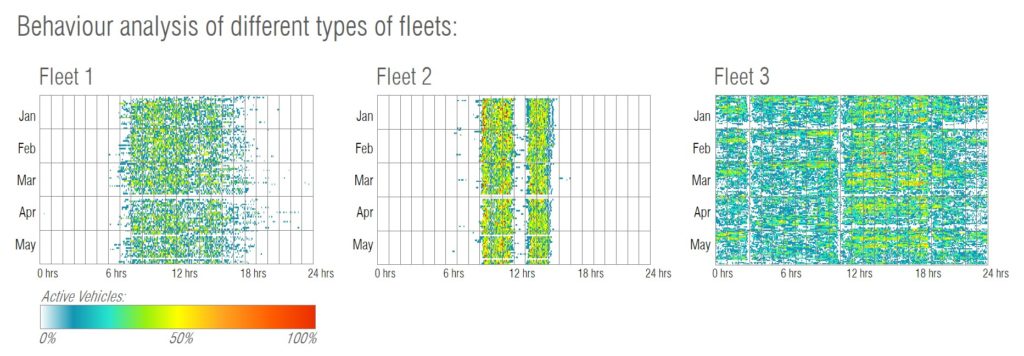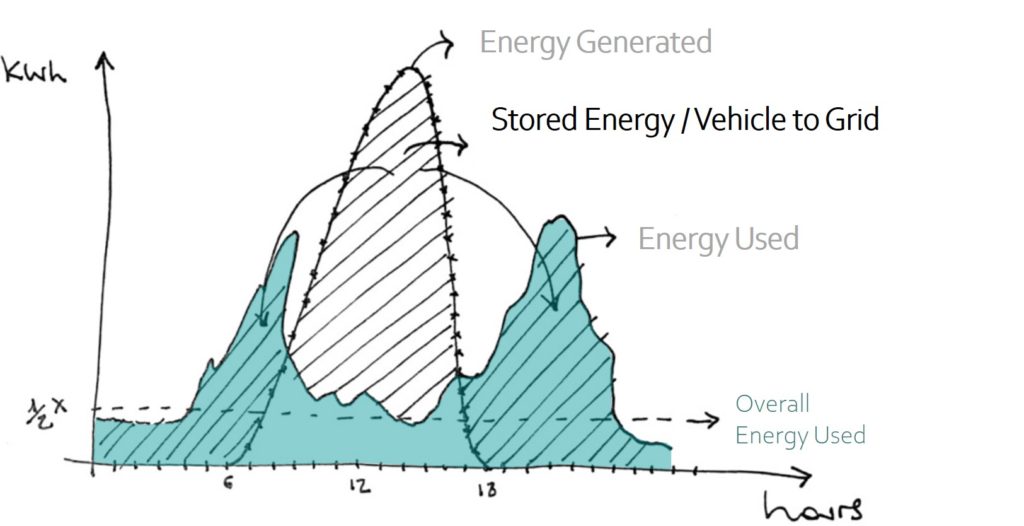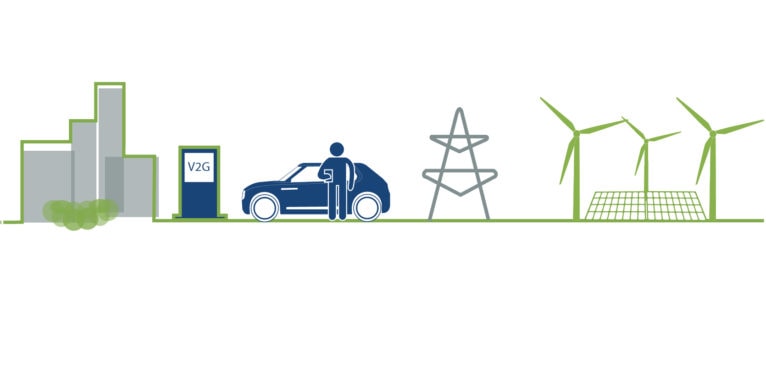EV-elocity is a research and development project looking at increasing the uptake of electric vehicles through helping consumers to monetise their investment using vehicle-to-grid (V2G) innovation. It will demonstrate the use of V2G technologies in a range of real-world situations to gain technical, customer and commercial insights. These is being explored through case studies where the technology is installed and tested.
Researchers from the Transport, Mobility and Cities and the Building, Energy and Environment Research Group from the University of Nottingham have been developing the V2G case study that will be tested at the University Park Campus. The project fits in well with the University’s commitment to make its campuses smarter and more sustainable, through the integration of innovative technologies with a focus on enhancing the users’ experience and reducing its carbon footprint (Figure 1).
The campus’ infrastructures and services are very much like those of a small town, so it is a great testbed for technology implementation prior to installation in our cities.

The challenge
The challenge for an optimum application of V2G technology is to synchronise the needs and requirements of the users and the different systems involved (transport, energy and buildings).
Our research correlates user behaviour analysis with datasets reflecting mobility patterns, electric vehicle charging requirements/trends, battery degradation, and electricity generation, storage and use, in order to define and assess different possible scenarios for the application of V2G chargers, with a view of maximising local renewable energy consumption, lowering costs for the user, improving battery life and reducing carbon emissions from the whole system.
At the heart of it all is the user, the vital component that keeps the system running.
The importance of analysing user behaviour
Understanding the patterns of usage of vehicles will allow us to evaluate the charging infrastructure required for electric vehicles (e.g. type of chargers, compatibility with V2G, location of the chargers, charging periods, energy demand, etc.). This will enable us to rethink the system and inform the users’ decision-making process in order to maximise benefits.
On campus we have different types of fleets, in terms of users, routines, parking location and dwell times. These are illustrated in Figure 2, that shows a sample of the activity of three different fleets; white means that all vehicles were stationary and red that all vehicles were active at that time. It is possible to observe that Fleet 1 has a diffused starting time, Fleet 2 has a strict operation and Fleet 3 operates 24/7 (read more about this in our publication and blog).

Following the study of these fleets and their users’ behaviour, we correlated this data with other parameters such as routes and movement patterns, renewable energy availability on site, grid cost and grid energy carbon emissions and identified the most promising charging pattern in order to deliver financial and carbon savings. We will then install two V2G units on campus and test whether our proposed usage delivers against our targets.
How V2G can contribute to the decarbonisation of the grid
The UK government has committed to reduce the UK’s net emissions of greenhouse gases by 100% relative to 1990 levels by 2050. Achieving zero emissions will require the UK to strike a balance between the amount of greenhouse gas emissions produced and the amount removed from the atmosphere. Circa 80% of the UK’s emissions come from transport (which is rapidly moving towards electrification), energy supply (particularly electricity generated from burning coal, oil and gas), business energy use (mostly electricity), and residential energy use (mostly for heating homes using gas but also moving toward electrification). When this is considered, it is easy to see why decarbonising electricity is a key part of the picture. However, electrification also comes with problems as the current infrastructure cannot support this additional capacity.
Because fleet vehicles are circa 5.3 million in the UK and amount to huge number of miles travelled, fleet electrification is considered critical to enable electrification of transport in the UK. A PricewaterhouseCoopers’ report (available here) suggested that based on Office for National Statistics 2018 data, if all UK’s fleet vehicles were to switch to zero emission models, it would save as much as 25% of all UK transport emissions. If we were to combine that with a better use of locally generated renewable energy, and vehicles that are able to import, store and export electricity when convenient, as enabled by V2G technology, we could significantly increase that impact whilst reducing the pressure in the infrastructure.
Figure 3 illustrates how V2G can help decarbonise the energy grid. The peak energy generation from renewable sources (e.g. photovoltaics) is often when the electricity demand is low. Therefore, there is a need to increase the system’s storage capacity to support flexibility and the better utilisation of this energy. With V2G technology, the battery of electric vehicles can be used to import and store the excess energy and export it back to the grid during peak demand (when the carbon intensity of the grid is higher).
Vehicles can essentially act as battery storage for cities, helping reduce emissions and improve the energy system reliability.

As soon as our case study is up and running, you will hear from us again. In the meantime, you can learn more through the publications below:
- Decarbonising our transport system: Vehicle use behaviour analysis to assess the potential of transitioning to electric mobility
- Where Will You Park? Predicting Vehicle Locations for Vehicle-to-Grid
- Towards an electric revolution: a review on vehicle- to-grid, smart charging and user behaviour
Blog by:
Professor Lucelia Rodrigues, Chair in Sustainable and Resilient Cities, Director of Transport, Mobility & Cities @ Nottingham, Course Director of MArch in Architecture & Sustainable Design, Department of Architecture & Built Environment, University of Nottingham
Dr Julie Waldron, Research Fellow, Building, Energy and Environment Research Group & Transport, Mobility & Cities @ Nottingham, University of Nottingham
The Project EV-elocity is part of the Vehicle-to-Grid (V2G) competition, funded by the Department for Business Energy and Industrial Strategy (BEIS) and the Office for Low Emission Vehicles (OLEV), in partnership with Innovate UK, part of UK Research and Innovation.
In January 2018, OLEV and BEIS announced that 21 projects (8 feasibility studies, 5 collaborative research and development projects, and 8 real-world v2g trial projects) were to receive funding of £30m to develop the business proposition and the core technology to support Vehicle 2 Grid deployment in the UK, including its demonstration with large scale trials.
The projects involve more than 50 industrial partners and research organisations from both the Energy and Automotive sector, marking the largest and most diverse activities on V2G in the world, and trialling more than 1,000 vehicles and V2G charger units across UK.
The V2G projects represent a significant step towards the transition to a low carbon transportation and a smart energy system. Allowing EVs to return energy to the Power Grid when parked and plugged for charging, will increase Grid resilience, allow for better exploitation of renewable sources and lower the cost of ownership for EV owners, leading to new business opportunities and clear advantages for EV users and energy consumers.


